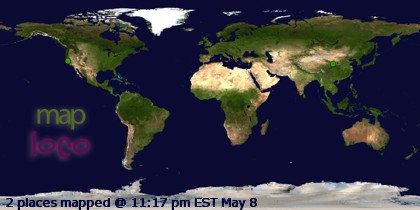 |
| No need to "share a straw" when you bring your own |

At the old house, a single mature dominant male would try and "own" a specific feeder, and chase off all other birds in a futile attempt to hoard the whole pint or whole quart of nectar to himself. Sometimes a mature male would let a female of the same species drink at "his feeder" but that was really only during mating season (in the late Winter and early Spring), and rarely ever in mid-day when sunlight was plentiful and visual acuity (to see if the birds were male, female, adolescent [not yet plumage differentiated] and which species was visiting) was much clearer. At "humming bird happy hour", AKA an hour before sunset as the shadows grow longer and ambient light substantially decreases, "tolerance" of other birds at a feeder increased and one might see 1/2 a dozen birds drinking at the same time from the same feeder. It was mostly 1 dominant mature male, several females, and a handful of adolescents who were trying to appear as if they might be females of mating age... but it was often more than just one hummingbird at a specific feeder at happy hour.
 In the new canyon rim home, the fence adjacent feeders are now remarkably successful beyond our wildest dreams. There are often 10 birds perched, drinking from 10 holes, as 2 to 4 more birds hover nearby, waiting their turn. Sometimes there at 11 or 12 birds drinking from 10 holes. Occasionally there's a feisty Rufous or Anna's mature male who tries to drive off other birds, but the mature females Generally Ignore such trouble makers. "We have nests to feed!" "Can't a lady get a drink?" and "No thanks, I already mated" are chirped phrases I imagine (project) are stated at every happy hour where the majority of the hummingbirds are mature females and adolescents, with just one or two males trying to get a drink alongside as well.
In the new canyon rim home, the fence adjacent feeders are now remarkably successful beyond our wildest dreams. There are often 10 birds perched, drinking from 10 holes, as 2 to 4 more birds hover nearby, waiting their turn. Sometimes there at 11 or 12 birds drinking from 10 holes. Occasionally there's a feisty Rufous or Anna's mature male who tries to drive off other birds, but the mature females Generally Ignore such trouble makers. "We have nests to feed!" "Can't a lady get a drink?" and "No thanks, I already mated" are chirped phrases I imagine (project) are stated at every happy hour where the majority of the hummingbirds are mature females and adolescents, with just one or two males trying to get a drink alongside as well.  |
| Um, I think I left my ID back at the nest... (12 birds on a 10 holed feeder, some of them undoubtedly nest mates) |
We have at least 5 species of hummingbirds who visit our feeders. I will state them here by rank of "most plentiful" to "least plentiful, more rare" as seen in our backyard. Thanks to Cornel's All About Birds site, (and Audobon's site... since Cornel's is not loading in many instances today) you can learn more about them as well, if you follow the links:
Anna's: https://www.allaboutbirds.org/guide/Annas_Hummingbird/id The NBA players of the hummingbird world; 20% bigger than everyone else.
Costa's; https://www.audubon.org/field-guide/bird/costas-hummingbird
Rufous; https://www.audubon.org/field-guide/bird/rufous-hummingbird ; small but pugnacious
Allen's; https://www.allaboutbirds.org/guide/Allens_Hummingbird/overview
Blackchinned; https://www.allaboutbirds.org/guide/Black-chinned_Hummingbird/id

When I inquired to Cornel as to how much nectar a single hummingbird (using an Anna's as an example) consumes in a day, I was given the following answer:
Anna's Hummingbirds weigh on average about 1.95 grams.
Hummingbirds consume 1/2 their body weight each day on nectar, gnats, spiders, and small insects. The nectar provides carbs while the insects provide protein.
 ...so if I am making At Least one quart a day (or 1000 milliliters) of nectar for the feeders along the fence, and each bird drinks a maximum of 1 ml each day (as 1 ml of water - 1 gram... the beauty of metric measure), then I am feeding 1000 birds every single day in my backyard. Some hotter days, when we have Santa Anna winds, the birds are consuming 2 quarts per day.
...so if I am making At Least one quart a day (or 1000 milliliters) of nectar for the feeders along the fence, and each bird drinks a maximum of 1 ml each day (as 1 ml of water - 1 gram... the beauty of metric measure), then I am feeding 1000 birds every single day in my backyard. Some hotter days, when we have Santa Anna winds, the birds are consuming 2 quarts per day.
Dr Desert Flower and I know this has led to a significant increase in the local hummingbird population, as well as helping to sustain mutations and variations that otherwise would probably rapidly perish "in the wild" without a government run, free nectar for the 99% program, such as we are providing. We've seen beak mutations (bumped beaks, split beaks, frayed ends of beaks, broken beaks) at both the previous home's backyard and our current canyon rim home. We've watched a severely bumped beak "male" try and take over a backyard feeder and dominate it, only to molt the next year (with the same bumped beak) into a female with muted plumage - perhaps a hermaphroditic XXY or androgen desensitivity mutation? It's no longer "survival of the fittest" in our backyard, but the prospering of the most social, least combative. And all it costs me is 4 pounds of sugar every 4 or 5 days. A social safety net well-worth sustaining.


No comments:
Post a Comment
Note: Only a member of this blog may post a comment.